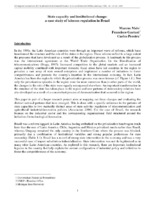| dc.contributor.author | Melo, Marcus André Barreto Campelo de | |
| dc.contributor.author | Gaetani, Francisco | |
| dc.contributor.author | Pereira, Carlos | |
| dc.date.accessioned | 2018-09-02T05:40:30Z | |
| dc.date.available | 2018-09-02T05:40:30Z | |
| dc.date.issued | 2005-10 | |
| dc.identifier.uri | http://cladista.clad.org//handle/123456789/3908 | |
| dc.description.abstract | The preceding analysis shows that Anatel has represented an important process of institution-building and is a robust institution. The telecommunications sector in Brazil has been depicted as a success story and much of the accomplishments in terms of expansion of coverage and quality of service - are due to the role played by Anatel. However, this agency diverts from the idealized model of regulatory institution in a number of very important ways. Furthermore, many of the results were non-anticipated outcomes. First, it never had financial autonomy and its resources continue to be impounded. This has reduced the agency's autonomy but still an important degree of autonomy remained. Second, Anatel has never had its own career staff. Despite the existence of a highly qualified cadre of technicians, the fact that many staff was recruited from other institutions weakens it. Third, it failed in important ways to introduce competition because the mirror companies in local telephone services represent a minuscule share of the market. | |
| dc.description.abstract | Fourth, despite the fact that the agency is very transparent, public hearings and other mechanism for participation do not guarantee effective participation by consumers as a result of information asymmetries that remain. Notwithstanding it is the best regulatory agency in the country and compares very favorably with its counterparts in the region (Gutierrez 2003). A number of features of the broader institutional endowment of the country help explain the relative success of the experience. First, the executive displayed important agenda setting powers and was able to overcome a number of potential fragmenting tendencies of the political environment resulting from the functioning of federalism and form the fragmented party system. Moreover the broader bureaucratic capacity of the Brazilian state was also key to ensuring effective policy implementation even when these resources were at odds with the independent agency model. More importantly, a tradition of contracts being upheld in the courts also helped creating a stable political and institutional environment. | |
| dc.format.extent | 31 p. | |
| dc.language | Inglés | |
| dc.publisher | Universidade Federal de Pernambuco. Escola Graduada de Ciências Políticas | |
| dc.rights | Creative Commons BY-SA-NC 4.0 Int | |
| dc.rights.uri | http://creativecommons.org/licenses/by-nc-nd/4.0/ | |
| dc.subject | CONGRESO CLAD 10-2005 | |
| dc.subject | REFORMA ADMINISTRATIVA | |
| dc.subject | DESARROLLO INSTITUCIONAL | |
| dc.subject | PRIVATIZACION | |
| dc.subject | EMPRESAS PUBLICAS | |
| dc.subject | PROCESO DE REGULACION | |
| dc.subject | CAPACIDAD ESTATAL | |
| dc.subject | TELECOMUNICACIONES | |
| dc.subject | ESTUDIO DE CASOS | |
| dc.title | State capacity and institutional change: a case study of telecom regulation in Brazil | |
| dc.type | article | |
| clad.congress | Congreso Internacional del CLAD sobre la Reforma del Estado y de la Administración Pública, 10 | |
| clad.key | MFN37512--37512 | |
| clad.key1 | KEY37512 | |
| clad.region | BRASIL | |
| clad.md5 | 70d3955cb55bc26cb19be63f1364a2d5 | |


